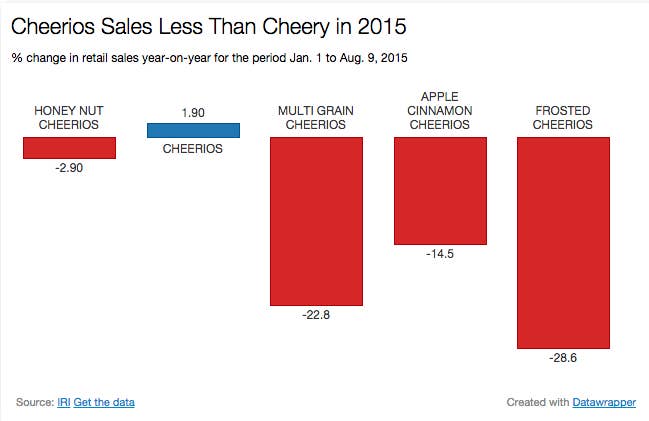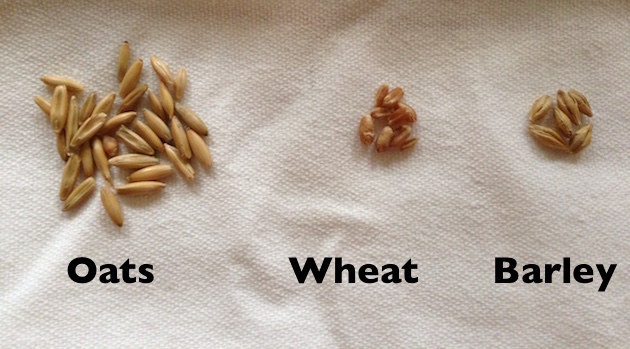The cereal business may be in gradual decline as Americans turn to other options at the breakfast table, but Cheerios-maker General Mills has made a big bet on a dietary trend that could keep its products at the front of the pack: it's going all in on gluten-free cereal.
The words "gluten-free" themselves may elicit some eye-rolling, often being associated with the unending list of frivolous diets, but it is no longer just a fringe trend. This summer, General Mills started switching out all boxes of Original, Honey Nut, Apple Cinnamon, Frosted, and Multi-Grain Cheerios for new, gluten-free versions. These five varieties represent about 88% of all Cheerios sales.
By January, Lucky Charms will be gluten-free too. "We're certainly expecting growth," said Jim Murphy, president of General Mills' cereal division, to BuzzFeed News.
It's no secret that Americans are turning away from cereal at breakfast time — in 1996, 38% of Americans began their day with a bowl of cereal, according to NPD research, a number that fell to 29% by 2014. But gluten-free foods are already a billion dollar business, and sales are expected to continue growing rapidly over the next few years. The logic behind General Mills' strategy is clear — if not for the quiet sense that gluten-free food may be nothing more than ephemeral diet fad. Many consumers who have simply elected to try a "gluten-free lifestyle" may eventually abandon it, after all.
But, Murphy said, "We don't think the gluten-free trend has stopped yet."
If the cereal program goes well, General Mills could further ramp up its gluten-free efforts as it looks for ways to battle declining sales overall. Across all of its brands, which include other cereals, Betty Crocker, Pillsbury, Green Giant, Yoplait, and Lärabar among many others, the company already offers more than 850 products (which counts various flavors individually) labeled gluten-free, which is still just a small part of its total portfolio.
In 2014, General Mills had a roughly 4.5% share of the U.S. gluten-free food market, according to estimates from market research publisher Packaged Facts, a small share for the giant company. What began as a niche category with niche brands for consumers with a medical need to avoid gluten now has an unlikely champion in General Mills, and it's just begun tinkering with making products as mainstream as Cheerios gluten-free.

Gluten-free foods have a stable customer base with the 1% of Americans who have celiac disease, an autoimmune disorder that damages the small intestine when gluten is consumed. Another 6% have gluten sensitivity, meaning eating gluten gives them symptoms such as foggy headedness, abdominal pain, bloating, and diarrhea. Together, these are roughly 21 million consumers, which itself is a significant market.
Yet it's the many more millions of "gluten-free lifestyle" consumers that have recently drawn the attention of major food companies: 30% of Americans say they are buying gluten-free products, and even more think these foods are "beneficial for everyone," reported U.S. News and World Report. As questionable a conclusion as that may be, the trend has spawned products from gluten-free dog food to shampoos. Research from Packaged Facts shows the majority of gluten-free consumers are female, white, and married or partnered.
This widespread gluten-aversion is certainly not the only problem for cereal makers, who are competing against a growing variety of breakfast foods at home and in restaurants — but it's one General Mills thinks it can address.
The company is looking to recreate the success it saw with Chex after it started marketing the gluten-free properties of the rice-based cereal in 2008, General Mills' first foray in this category. Chex sales have grown by double digit percentages each year since 2010, said Murphy. "It was a brand that was pretty sleepy, and that gave it a real jolt."
Now, the stakes are even higher with Cheerios, which is roughly five times as big a brand as Chex in terms of sales (Honey Nut Cheerios remains the country's best selling cereal), but is struggling against declining cereal consumption overall. Retail sales of all cereals fell 4% in 2014, and slid another 1.5% year on year so far in 2015, according to data from IRI, a Chicago-based market research firm.
Some Cheerios varieties have fared far worse. For General Mills, the gluten-free campaign is worth a shot.
As it reconsiders gluten, General Mills is simultaneously introducing more high-protein products, and removing artificial ingredients from its cereals. "These three big buckets are powerful trends," said Murphy.
Still, there are signs that going gluten-free isn't necessarily a silver bullet. For instance, General Mills recently announced that it will discontinue gluten-free Chex oatmeal, which never reached a large enough sales volume for the company to put significant marketing dollars behind the product. "It just didn't work," said Murphy.
The immediate goal is to bring gluten-free consumers back to the cereal aisles. But to retain these customers beyond what could be a short-lived diet fad, General Mills figured the worst thing it could do would be to make gluten-free products more expensive.

To go gluten-free without a price hike, General Mills added a step to its manufacturing process.
Cheerios are made from oats, which are naturally gluten-free, but the oats are sometimes contaminated from the harvesting equipment with gluten-filled wheat, rye, and barley. Rather than switching to a supplier that would guarantee oats free of these other grains — which would be more costly — General Mills opted to stick with the same suppliers, but designed new equipment that would filter out any wheat, rye, and barley (the grains are all different sizes and can be sifted out) so that the remaining oats would meet U.S. FDA gluten-free standards. With the exception of Multi-Grain Cheerios, the cereals did not need to be reformulated, so they taste exactly the same.
The company invested millions of dollars into building a new facility in Minnesota to house this equipment, but believes it is a more cost-effective alternative in the long term than switching to a gluten-free oat supplier.
The facility will sort through 1 billion pounds of oats annually for now, and "hopefully more in the future," said Murphy.
